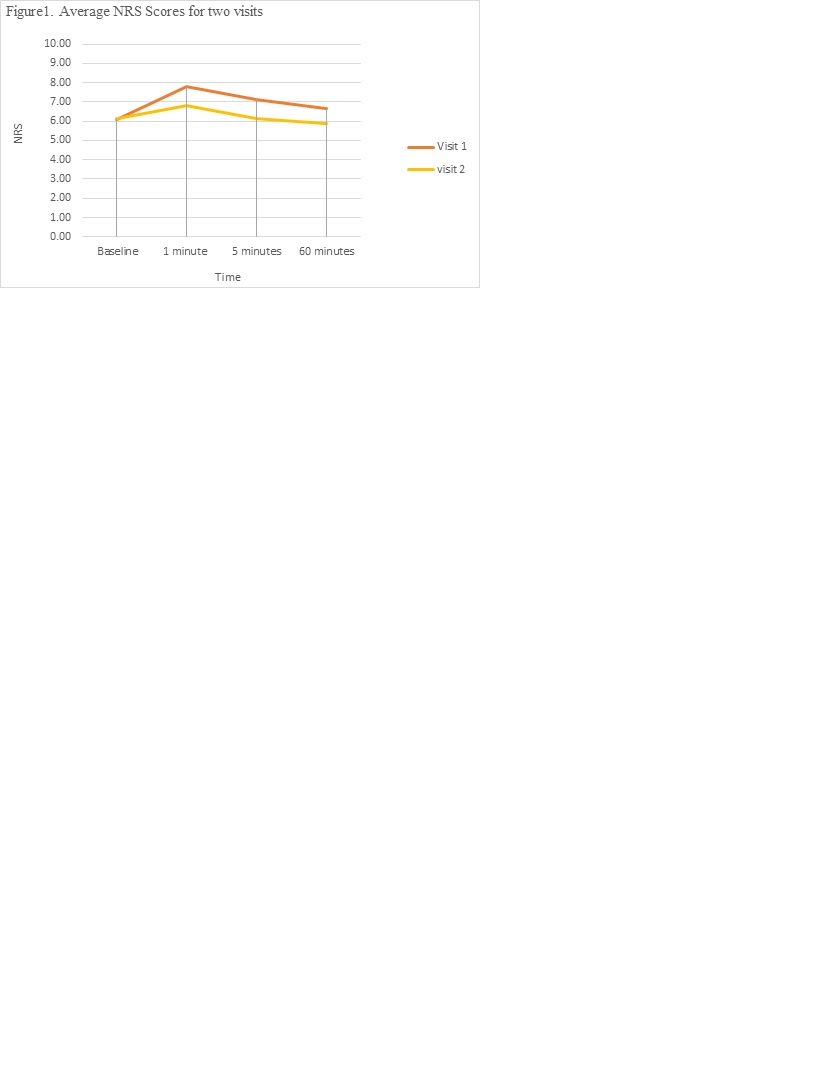Session Information
Session Type: Poster Session C
Session Time: 9:00AM-11:00AM
Background/Purpose: Pain, being one of the most crucial symptoms associated with knee OA, serves as a significant outcome measure for the increasing number of studies focusing on pain management strategies. Many people with OA have no or minimal pain at rest. Therefore, identifying procedures to evoke the pain associated with OA would be of value in evaluating both neurosensory pathways important for pain perception as well as possible acute interventions focused on relieving pain. We believe there is potential clinical value in differentiating and measuring pain during physical activity as a separate construct from pain at rest. In this study, we aimed to evaluate a novel method for inducing knee pain using a stair-stepper machine.
Methods: This study was part of a randomized, double-blind, cross-over trial to evaluate the efficacy of a topical treatment for patients with knee OA (NCT01654302). In this trial, 40 patients were assessed in 2 visits at least one week apart. In each visit, two exercise sessions were conducted, one before treatment and one after treatment. In this abstract, we focus on the findings of the first exercise session. After providing consent, patients reported their baseline pain level using a Numerical Rating Scale (NRS) from 0 to 10, with 0 meaning no pain and 10 meaning worst imaginable pain. Patients were instructed to use a commercially available stair-stepper machine (STAMINA, Springfield, MO) for a maximum of 2 minutes or until they reached maximum bearable pain. After completion of the exercise, participants assessed their knee pain intensity at 1, 5, and 60 minutes after stopping. The primary outcome measure was a change in pain intensity after exercise. To evaluate if exercise caused a significant increase in pain, we conducted a repeated measures ANOVA model to compare the NRS levels before exercise with those at 1 minute, 5 minutes, and 60 minutes after stopping exercise for two visits. Subsequently, we performed pairwise comparisons using Tukey’s Honestly Significant Difference (HSD) test to further examine specific differences between the time points.
Results: Participants included 24 females and 16 males with an average age of 58 ± 7.7 years; The average pain level is presented in Table 1 and Figure 1. The analysis revealed a significant effect (F(3,df) = 31.52, p< 0.001) for visit 1 and (F(3,df) = 3.95, p< 0.01) for visit 2, indicating differences among time points for both visits. Further analysis of multiple comparisons for visit 1 showed a statistically significant increase in NRS after 1, 5, and 60 minutes compared to the baseline. However, for visit 2, the only significant difference was observed for 1 minute compared to 60 minutes. This finding could potentially be attributed to the patients’ prior experience with the exercise method.
Conclusion: The ability to reliably and reproducibly generate movement-evoked pain in patients with knee OA holds promise for assessing acute treatment interventions as well as evaluating neurosensory pathways, e.g., brain MRI which can help define the basis for pain perception in OA. Further studies with larger sample sizes are warranted to validate this approach and assess its sensitivity to treatment-induced pain changes.
To cite this abstract in AMA style:
Bagherzadeh L, Thomas S, Espinosa-Salas S, Barroso J. Movement Evoked Pain as an Outcome Measure in Patients with Knee Osteoarthritis [abstract]. Arthritis Rheumatol. 2023; 75 (suppl 9). https://acrabstracts.org/abstract/movement-evoked-pain-as-an-outcome-measure-in-patients-with-knee-osteoarthritis/. Accessed .« Back to ACR Convergence 2023
ACR Meeting Abstracts - https://acrabstracts.org/abstract/movement-evoked-pain-as-an-outcome-measure-in-patients-with-knee-osteoarthritis/


